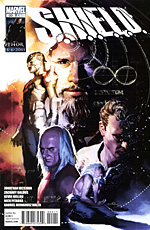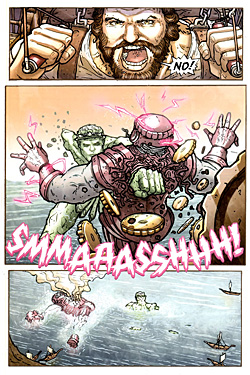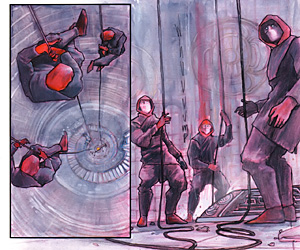 Written by Jonathan Hickman
Written by Jonathan Hickman
Art by Nick Pitarra, Zachary Baldus, Kevin Mellon, and Gabriel Hernandez Walta
48 pages, color
Published by Marvel
If I had to make a "top five comics from Marvel that have caused some long-time readers to go into a tailspin over the past several years" list, S.H.I.E.L.D. would certainly be on that list. Jonathan Hickman and Dustin Weaver’s stories of ancient history in the Marvel Universe (showing the S.H.I.E.L.D. organization spanning thousands of years, complete with alien invasions dating back to the time of the Egyptian Pharaoh Imhotep) mix our history with that of the fantastical from Marvel, and it seems at times almost designed to ruffle feathers. The idea of a S.H.I.E.L.D. Infinity issue sounded interesting, then, taking a break between the first and second volumes to let some other artists step in and draw vignettes from Hickman about the S.H.I.E.L.D. organization. But while I enjoyed it, I was a tiny bit disappointed in that as a potential jumping-on point, S.H.I.E.L.D. Infinity is anything but.
 Of the four stores in S.H.I.E.L.D. Infinity, only the first can stand in a vacuum and introduce people to Jonathan Hickman’s take on S.H.I.E.L.D.. Starting in 1497 Florence, it quickly jumps back in time to 226 BC, where a giant alien Kree is attacking Rhodes, and it comes down to Archimedes to power up the Colossus of Rhodes and use its massive size and power to beat down the invading enemy. In a nutshell, it’s the perfect example backdrop for S.H.I.E.L.D. as a whole, with Hickman taking established facts about both our world (the massive Colossus of Rhodes statue, one of the Ancient Wonders of World that stood over the entrance of Rhodes’ harbor) and the Marvel Universe (the Kree and their invading technology) and mashes them into a single unit. Reading S.H.I.E.L.D. means you need to accept the idea of these two concepts colliding, adding all of this fantastical technology not just during the eras in which the comics were published, but far into the past and retroactively making it a world of wonders. Hickman and artist Nick Pitarra knock this chapter out of the park, evoking the sense of awe that S.H.I.E.L.D. so often gives to the reader, and it helps that Pitarra’s art is a great cross between Arthur Adams and Geoff Darrow. Archimedes piloting the Colossus of Rhodes is one of the funnier things I’ve seen in a while, and I love all the gears, cogs, and pulleys that Archimedes uses to pilot it, even as the Kree threatens to destroy the Colossus once and for all.
Of the four stores in S.H.I.E.L.D. Infinity, only the first can stand in a vacuum and introduce people to Jonathan Hickman’s take on S.H.I.E.L.D.. Starting in 1497 Florence, it quickly jumps back in time to 226 BC, where a giant alien Kree is attacking Rhodes, and it comes down to Archimedes to power up the Colossus of Rhodes and use its massive size and power to beat down the invading enemy. In a nutshell, it’s the perfect example backdrop for S.H.I.E.L.D. as a whole, with Hickman taking established facts about both our world (the massive Colossus of Rhodes statue, one of the Ancient Wonders of World that stood over the entrance of Rhodes’ harbor) and the Marvel Universe (the Kree and their invading technology) and mashes them into a single unit. Reading S.H.I.E.L.D. means you need to accept the idea of these two concepts colliding, adding all of this fantastical technology not just during the eras in which the comics were published, but far into the past and retroactively making it a world of wonders. Hickman and artist Nick Pitarra knock this chapter out of the park, evoking the sense of awe that S.H.I.E.L.D. so often gives to the reader, and it helps that Pitarra’s art is a great cross between Arthur Adams and Geoff Darrow. Archimedes piloting the Colossus of Rhodes is one of the funnier things I’ve seen in a while, and I love all the gears, cogs, and pulleys that Archimedes uses to pilot it, even as the Kree threatens to destroy the Colossus once and for all.
Once this particular chapter is over, though, the remaining pieces serve more as gap-fillers for people who already read S.H.I.E.L.D. Volume 1. "The Hidden Message" from Hickman and Zachary Baldus is probably my favorite of these, thanks in part due to Baldus’s watercolor inspired pieces. The backgrounds shift from panel to panel between fully detailed, and a smear of color as the three infiltrators break into the Vatican. It’s a great overall look, and every page has a burst of excitement in the art. And while it’s a prologue to another story, it stands well enough on its own to still give the reader enjoyment if it was read in a vacuum.
 Less successful are the remaining two stories. "Life, the End of the World, and the Key" (with art by Kevin Mellon) has no pretenses of standing on its own at all. It’s very much part of S.H.I.E.L.D. Volume 1’s story, giving us more information its villain and his plans getting set in motion. As a story it’s just lukewarm—I’m not sure it gives us anything of particular interest, old or new reader alike—and the art is just all right, a sketchy style which doesn’t seem to fit with the other stories here or S.H.I.E.L.D. as a whole. It’s the most standard art style on display here, one that ultimately suffers in comparison rather than through any fault of its own.
Less successful are the remaining two stories. "Life, the End of the World, and the Key" (with art by Kevin Mellon) has no pretenses of standing on its own at all. It’s very much part of S.H.I.E.L.D. Volume 1’s story, giving us more information its villain and his plans getting set in motion. As a story it’s just lukewarm—I’m not sure it gives us anything of particular interest, old or new reader alike—and the art is just all right, a sketchy style which doesn’t seem to fit with the other stories here or S.H.I.E.L.D. as a whole. It’s the most standard art style on display here, one that ultimately suffers in comparison rather than through any fault of its own.
"The Apple," wrapping up S.H.I.E.L.D. Infinity, is another story that doesn’t bring terribly much to the big picture, once again filling in a small gap of story as Gottfried Leibniz and Isaac Newton face off against one another. The high point here is Gabriel Hernandez Walta’s art, but only in certain scenes. He’s at his best in the flashback scenes, drawn to look like woodcuts and presenting stark, deadly moments of Newton’s killings. It’s the action sequences in the "present" story that don’t work quite as well; for example, it takes a second to realize that Leibniz is tossing an apple to Newton, not holding out a still hand and causing the apple to levitate above it. There’s no good sense of movement here, and that’s a shame because it makes the climactic scene of "The Apple" to look staged and lifeless, not fast and deadly.
Overall, S.H.I.E.L.D. Infinity is an interesting sidestep for the series, giving Weaver an extra two months off to prepare for S.H.I.E.L.D. Volume 2 and letting Hickman tell some shorter stories set in the greater scheme of his comic. I just wish that, given the opportunity, it might have worked a bit better as a true stand-alone issue, not for all intents and purposes S.H.I.E.L.D. Volume 1 #7. For readers of S.H.I.E.L.D., definitely pick this issue up, it’s clearly as much a part of the series as any other. But for potential new readers? You’re probably better off by way of introduction with the first issue of the comic, or the collection that’s around the corner. S.H.I.E.L.D. is a great comic, but this is a less than idea first taste.
Purchase Links: Amazon.com | Powell’s Books
